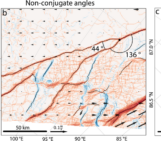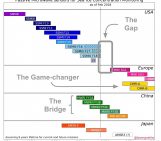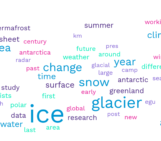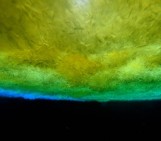
Wildfires in western Greenland in July 2019 were observed by the Landsat 8 satellite. [Photo credit: NASA/Visible Earth]
June, July and August 2019 saw extensive heat waves across Europe, with air temperatures reaching above 40°C in many countries. In response, record breaking ice melt was observed in Greenland and wildfires in Siberia, Alaska, Arctic Canada and Greenland occurred. A particularly dry and warm summer was responsible for hemisphere-wide changes to the cryosphere. In this week’s post, we will review some of the consequences of this very warm summer of 2019 on our Northern Hemisphere cryosphere.
Wildfires
Whilst wildfires are a natural occurrence in forests all over the globe, they are relatively uncommon in the cool, wet Arctic forests. However, with above average air temperatures over much of the Arctic, the conditions of last summer were perfect for widespread Arctic wildfires. One of the biggest problems associated with wildfires is the high CO2 emissions. Summer 2019 saw the highest CO2 emissions from wildfires inside the Arctic circle since 2003. Other direct effects of wildfires in the Arctic include poor air quality and black carbon particles falling on the ice, decreasing its capacity to reflect the sun’s rays (called albedo, which is normally high for the bright snow surface of the Arctic but can be reduced by dark-coloured dust, ash and algae). This reduced albedo of the ice means it absorbs more sunlight, causing it to warm and melt even more (see this post).
Record-breaking Greenland Melt
The term ‘record breaking’ in relation to melting in Greenland is becoming increasingly common. Summers of 2012, 2016 and 2019 have all seen extremely high melt rates, widespread areas of melt and early melt onset in Greenland. Summer 2019 was record breaking for all three of these metrics. Firstly, the melt extent (area of Greenland ice sheet simultaneously melting) peaked early in summer with approximately 30% of the ice sheet’s surface melting on June 13th. For the next two months, the melt extent was above average. A second peak in the melt extent occurred on August 1st, when almost 60% of the ice sheet was melting and over 11 Gigatons of ice was lost (1 Gigaton of water can fill 400,000 olympic size swimming pools).

The maximum melt extent on August 1st 2019, and a graph showing the melt extent throughout 2019. [Photo credit: Polarportal.dk]
Sea Ice Minimum
At the end of August, sea-ice minimum was below 4.6 million square kilometers, which was the third smallest area since the satellite record began. Earlier in the year, between March and June, the sea ice extent was the lowest ever recorded (see our previous blog post for more information about the reasons of this sea ice retreat). A particularly shocking picture of huskies running through bright blue water over the sea ice in northwest Greenland went viral this summer.
The loss of sea ice has multiple impacts on the climate and cryosphere. When the bright, white sea ice melts, it exposes the darker ocean surface. As the dark ocean surface has a lower albedo (is darker) than sea ice, more sunlight is absorbed, further warming the area. This is called Arctic Amplification (see this post). Sea ice loss can also impact the Greenland ice sheet! A loss of sea ice near the coast of Greenland can cause glaciers to calve (large chunks break away) into the ocean when the pressure of the sea ice is removed. Spalte glacier, a tributary of the larger 79°N glacier in the northeast of Greenland, lost an area the size of Manhattan this summer. The whole northeast region had reduced sea-ice cover throughout summer.

A large part of the Spalte Glacier in northeast Greenland detached after the warm summer of 2019. Figure credit: Prof. Jason Box and Karina Hansen
Melting in the Alps
The two European heat waves experienced in June saw air temperatures above 40°C across Spain, France and Germany. These high, sustained temperatures led to high levels of melting across the European Alps. On the highest mountain in Europe, Mount Blanc, a mountaineer discovered a huge melt lake at 3km above sea level, which developed only a few days after the late June heat wave.

Slushy, wet snow and ice has a blue hue. Large parts of sea ice and land ice have the characteristic blue colour of melting ice this summer. [Photo credit: Robert Bye, Unsplash images]
Was summer 2019 just a blip? Or a sign of things to come? Whilst we don’t know the future, it is becoming increasingly clear that record breaking air temperatures and ice melt are becoming more common, which makes many Arctic communities and cryospheric features vulnerable.
Further reading:
- Climate Change & The Cryosphere – Why is the arctic sea-ice cover retreating?
- Black carbon: The dark side of warming in the arctic
- Image of the week – Climate feedbacks demystified in polar regions
- Unearthed – How burning forests can help melt ice sheets
- Polar Portal – Monitoring Ice and Climate in the Arctic
Edited by Violaine Coulon
Jenny Turton is a post-doc at Friedrich-Alexander University (FAU) in Erlangen, Germany. Her research focuses on the atmosphere-cryosphere interactions in Northeast Greenland using observations and atmospheric modelling. Her research forms part of a larger project focusing on the ice-ocean-atmosphere links in the 79° north glacier in Greenland.





